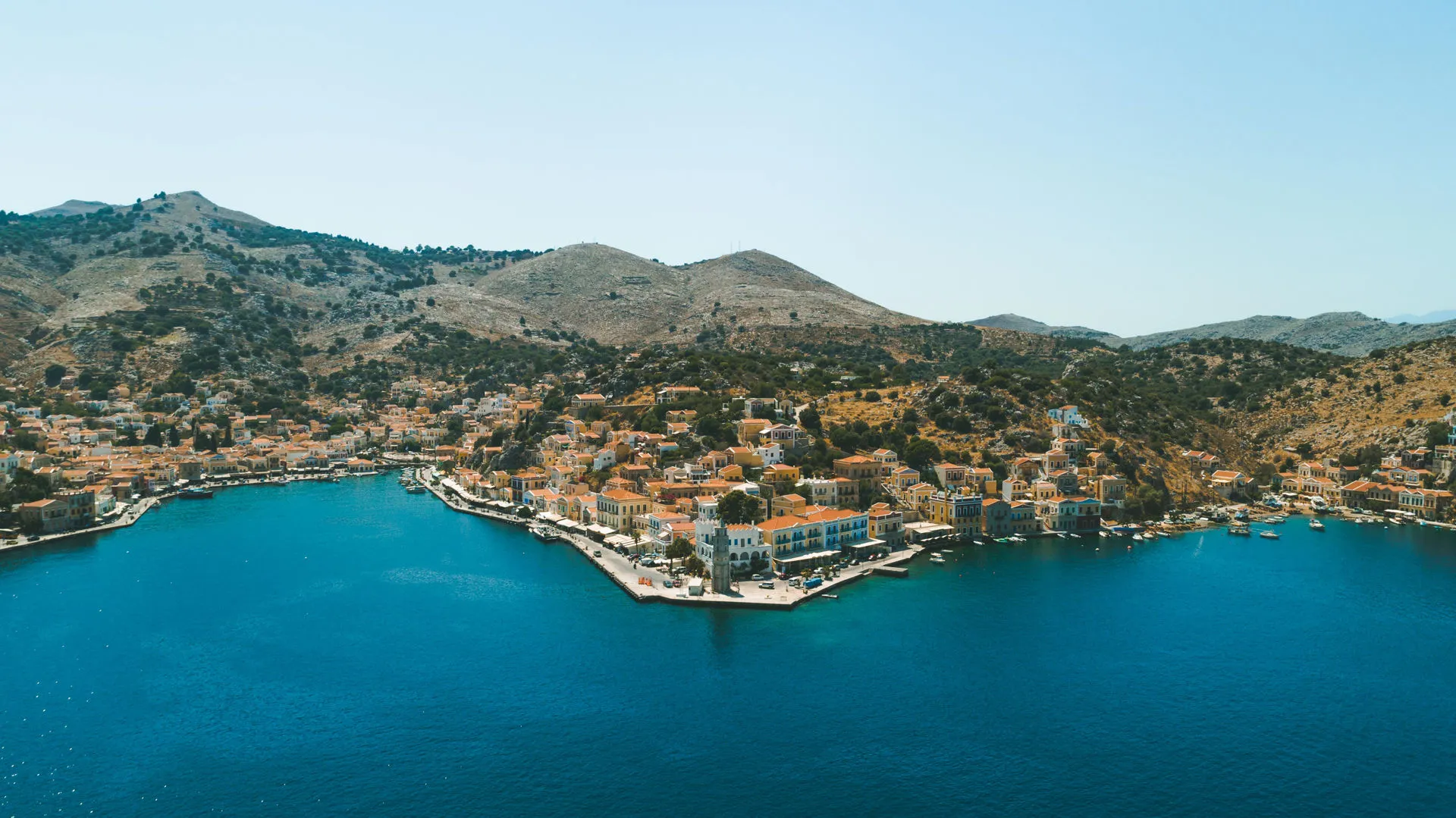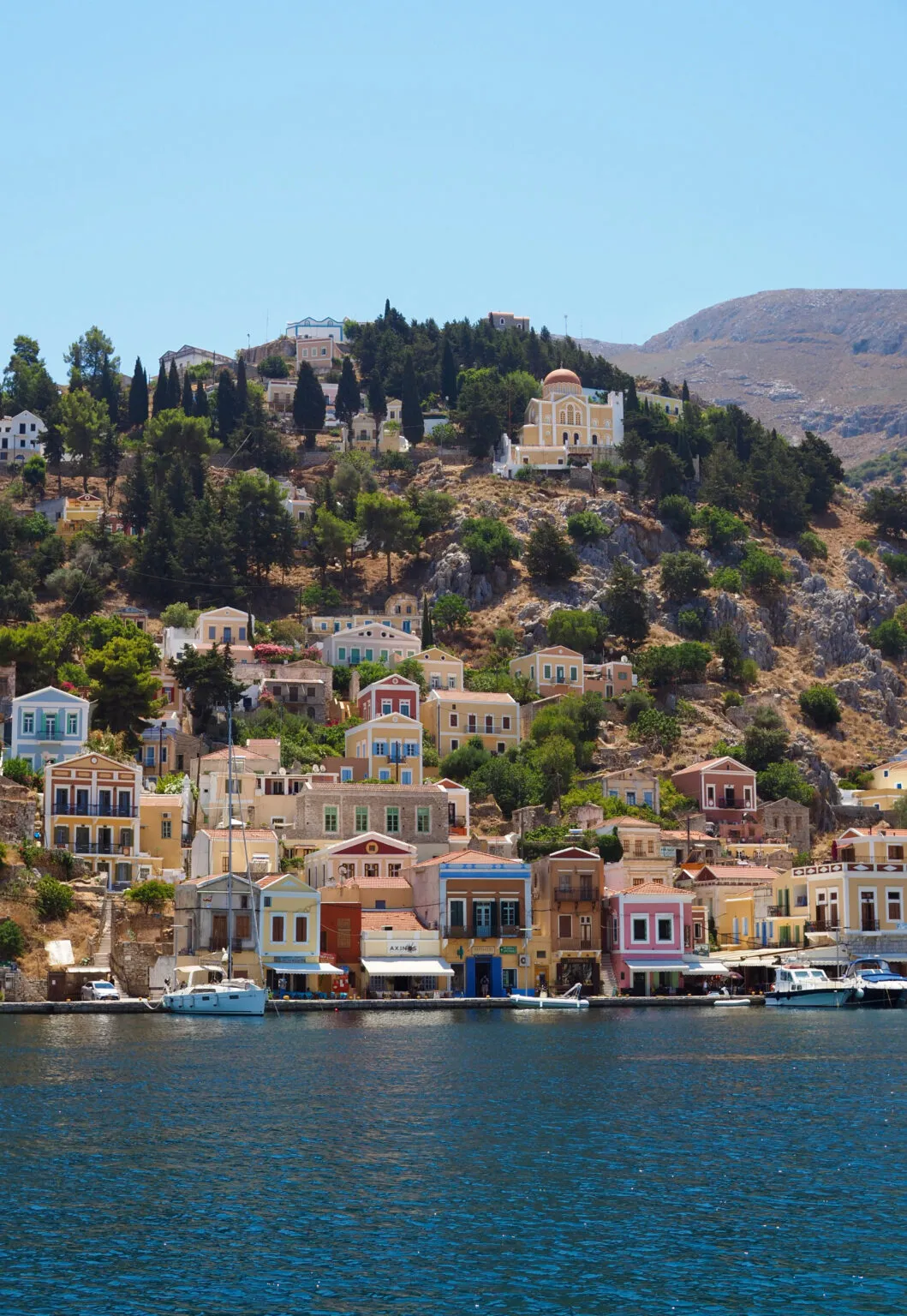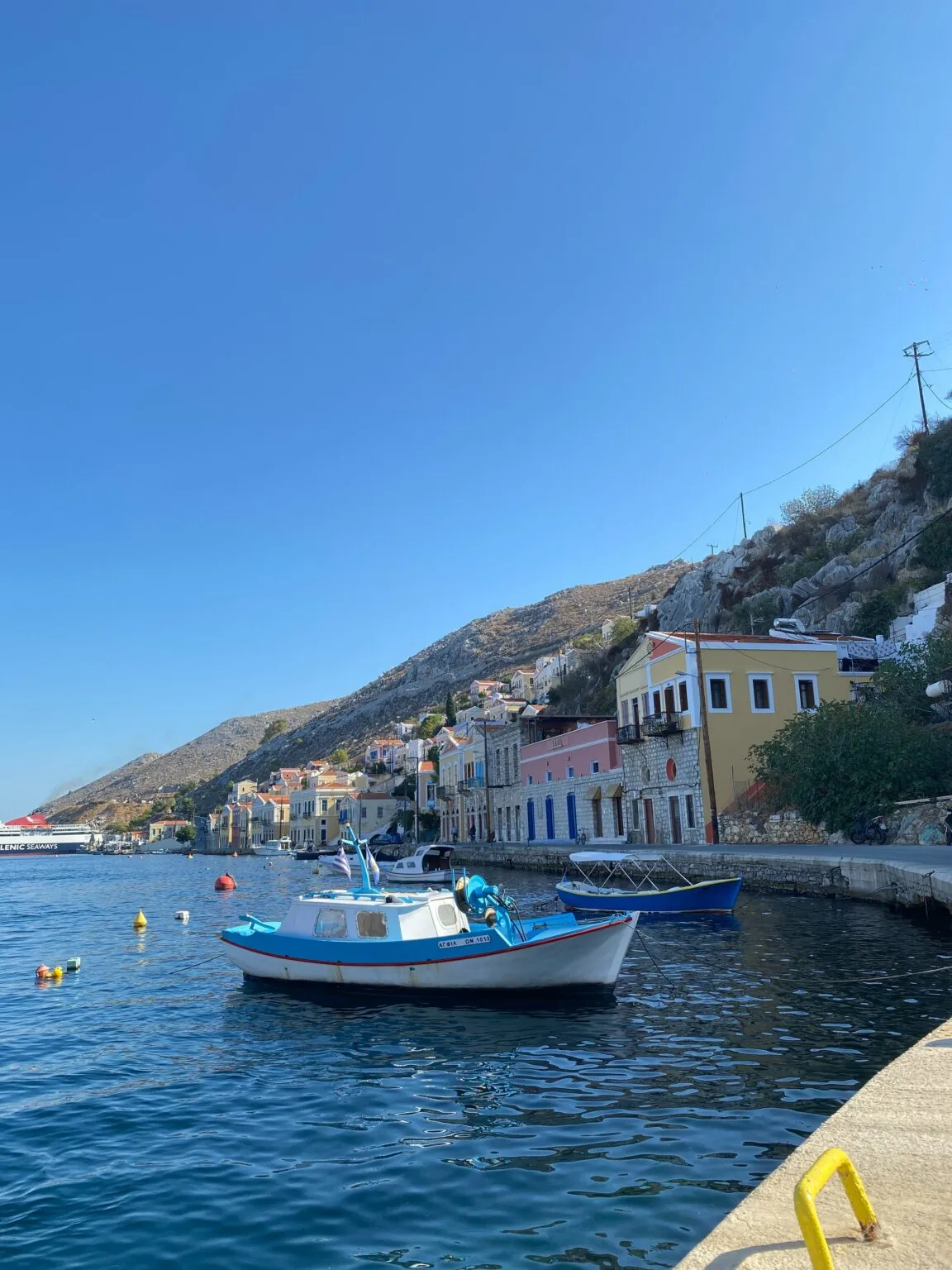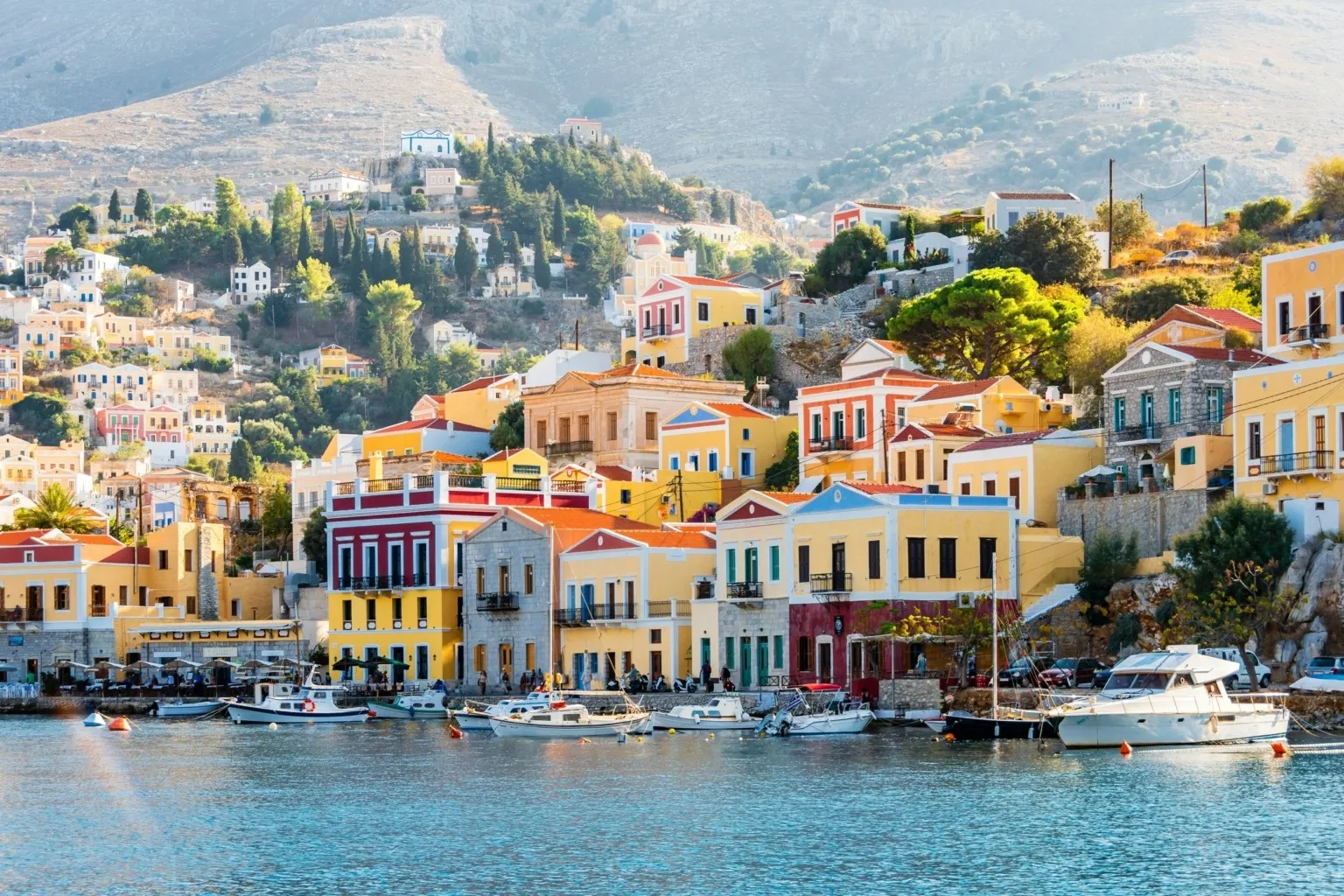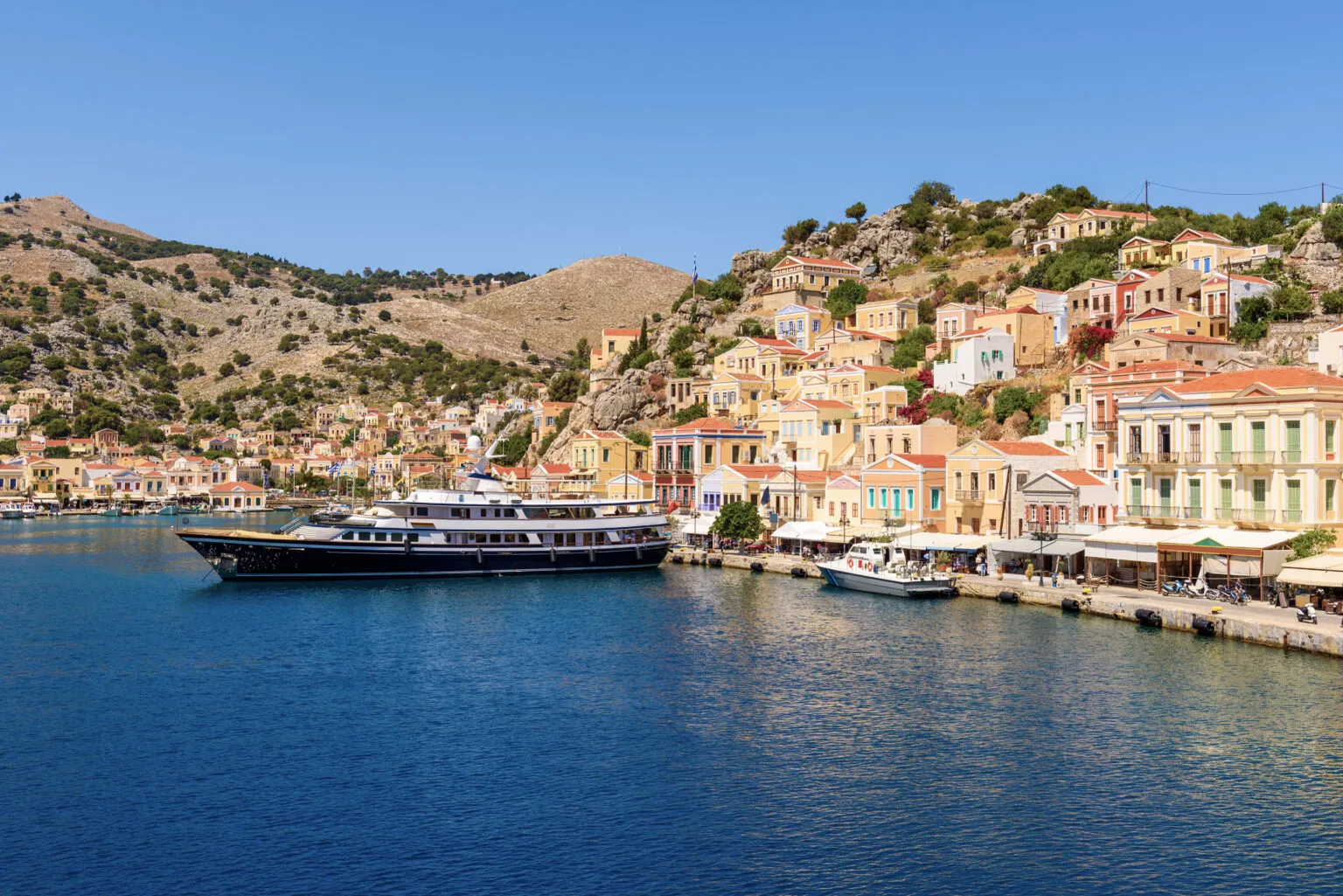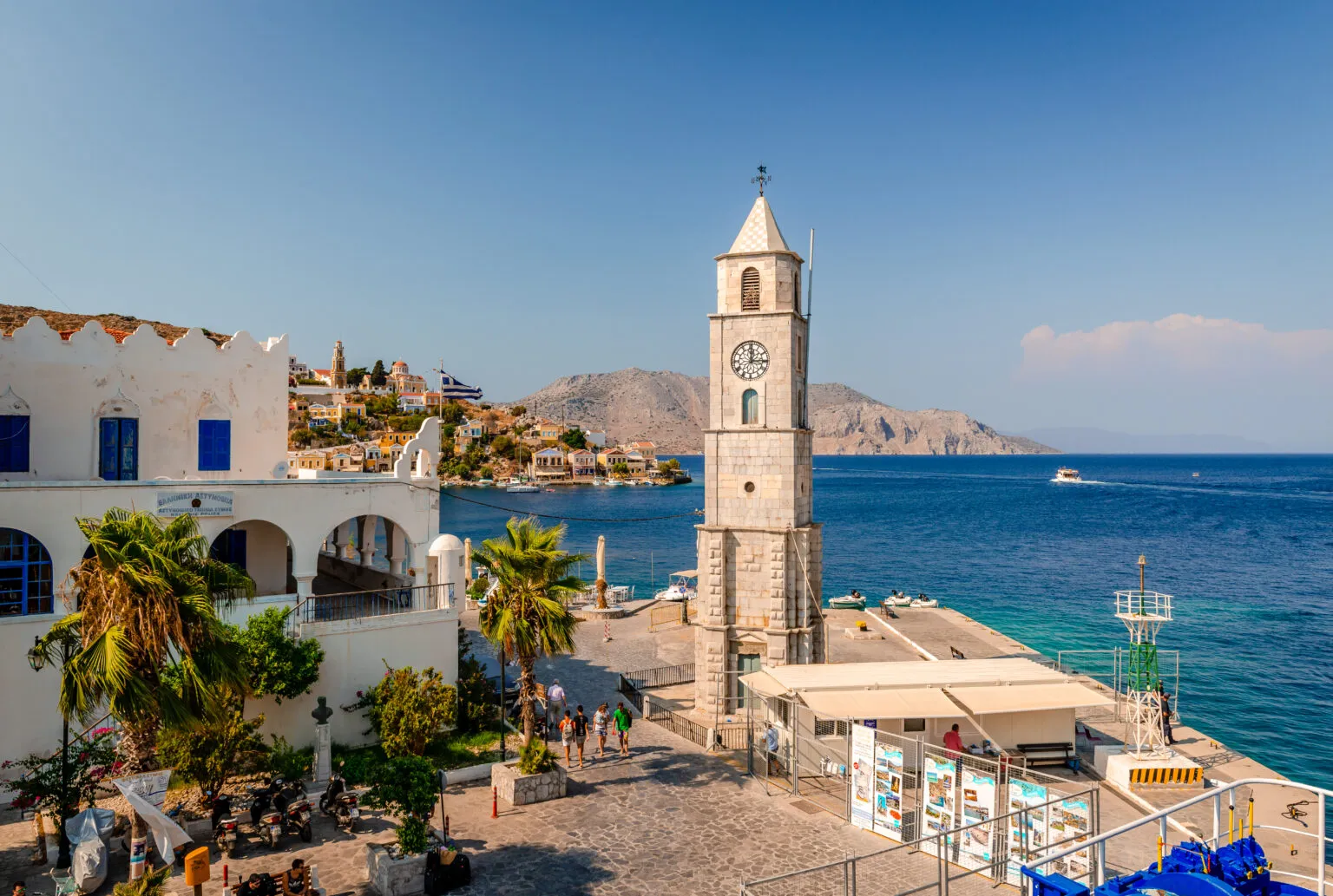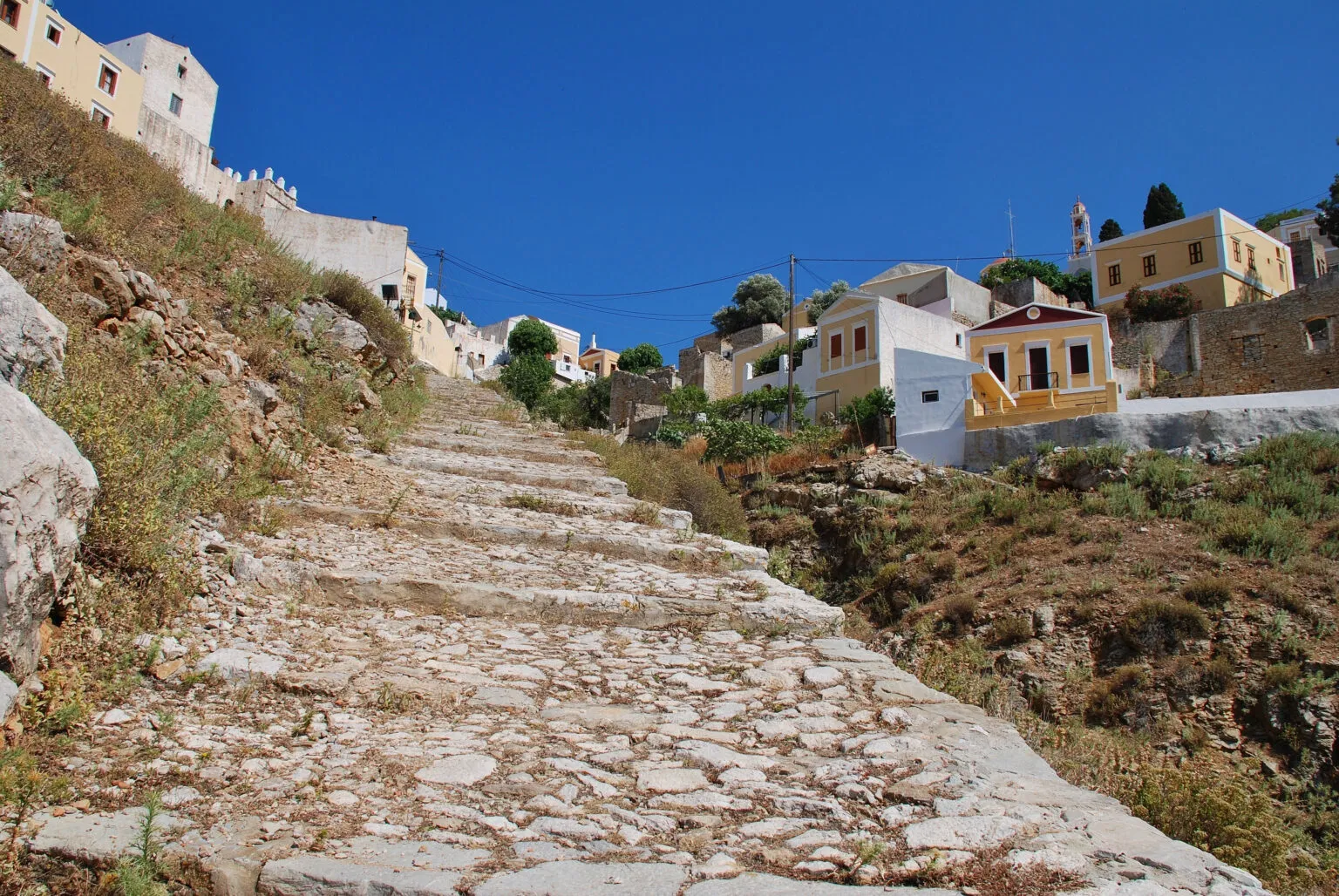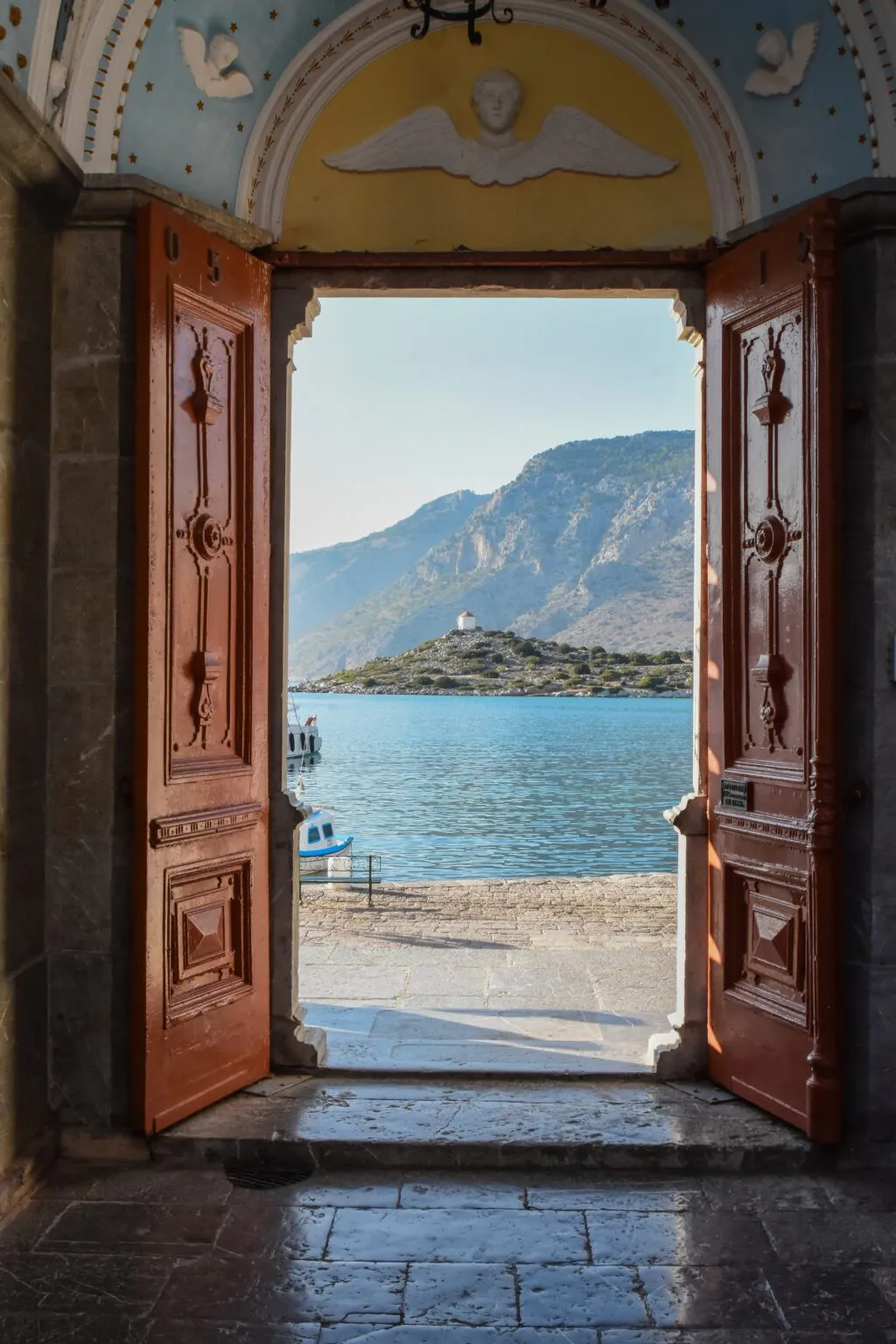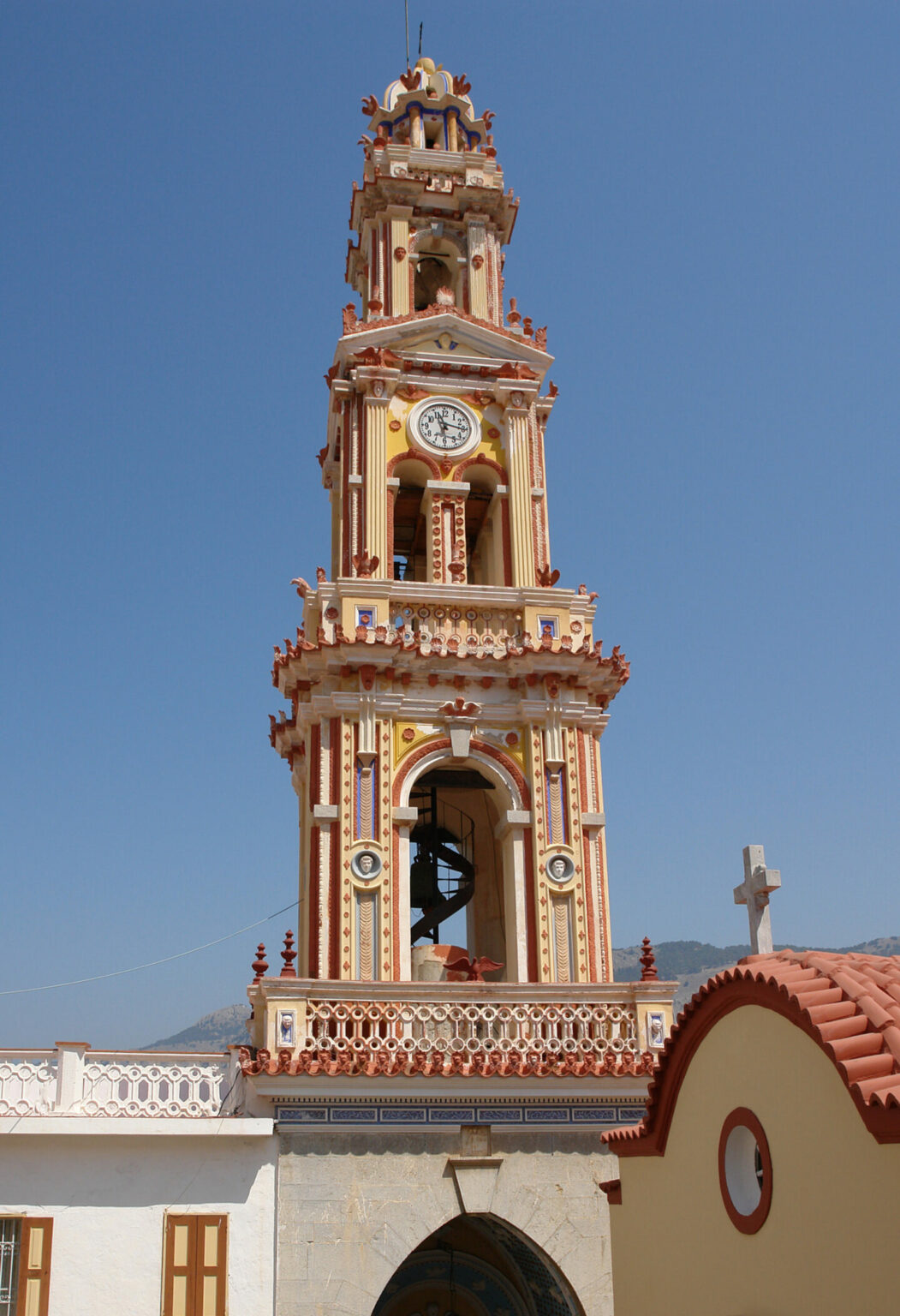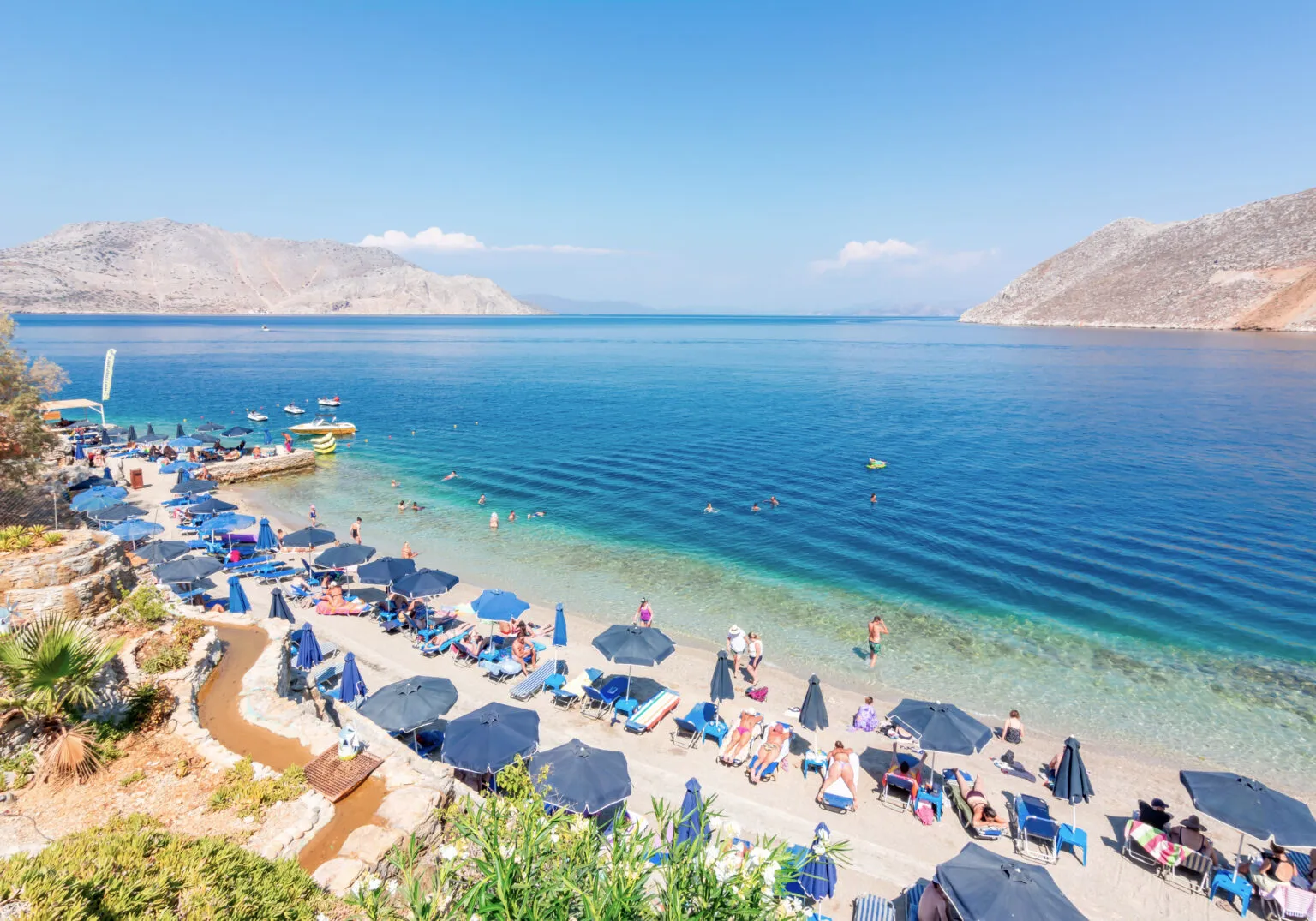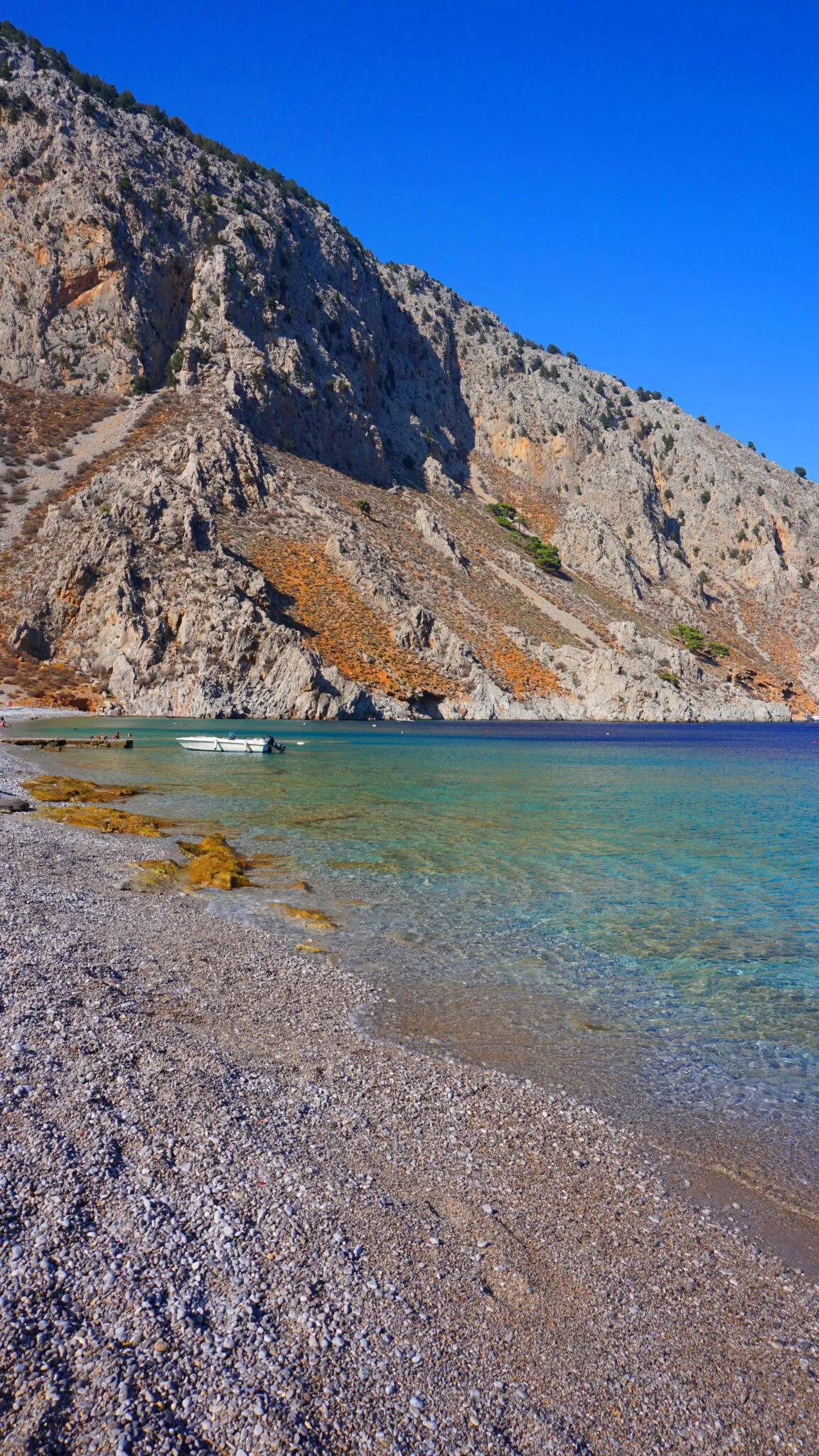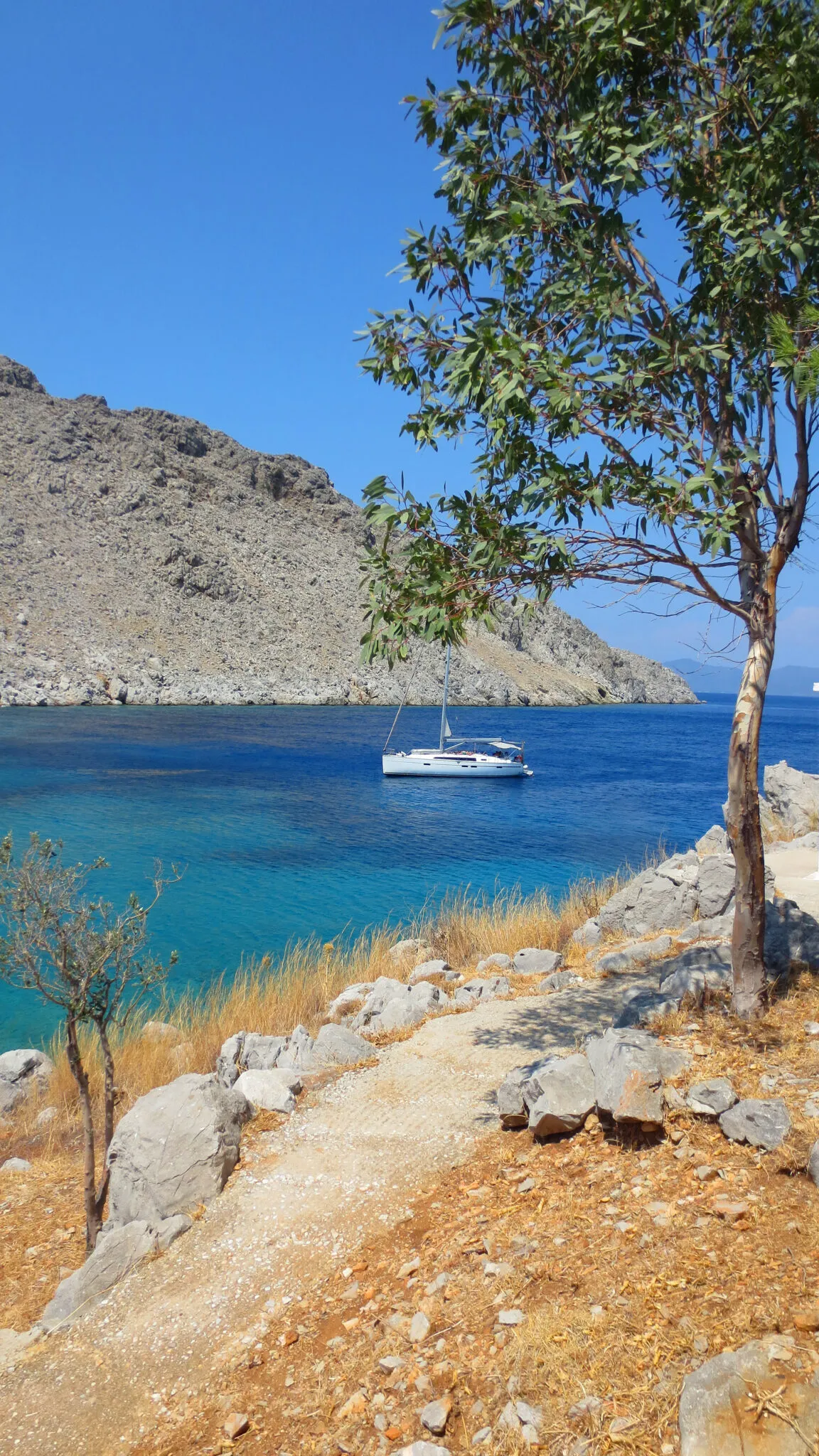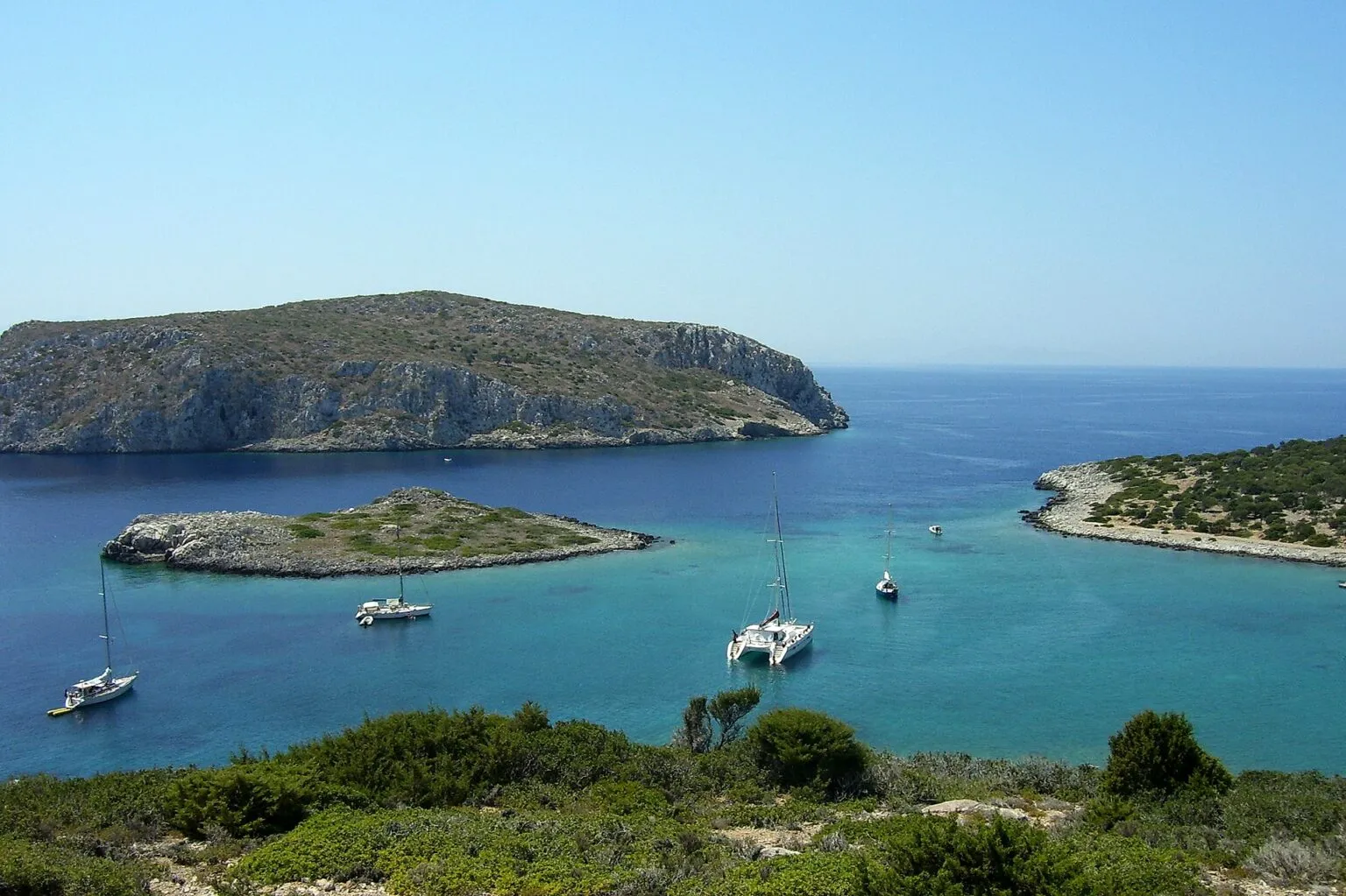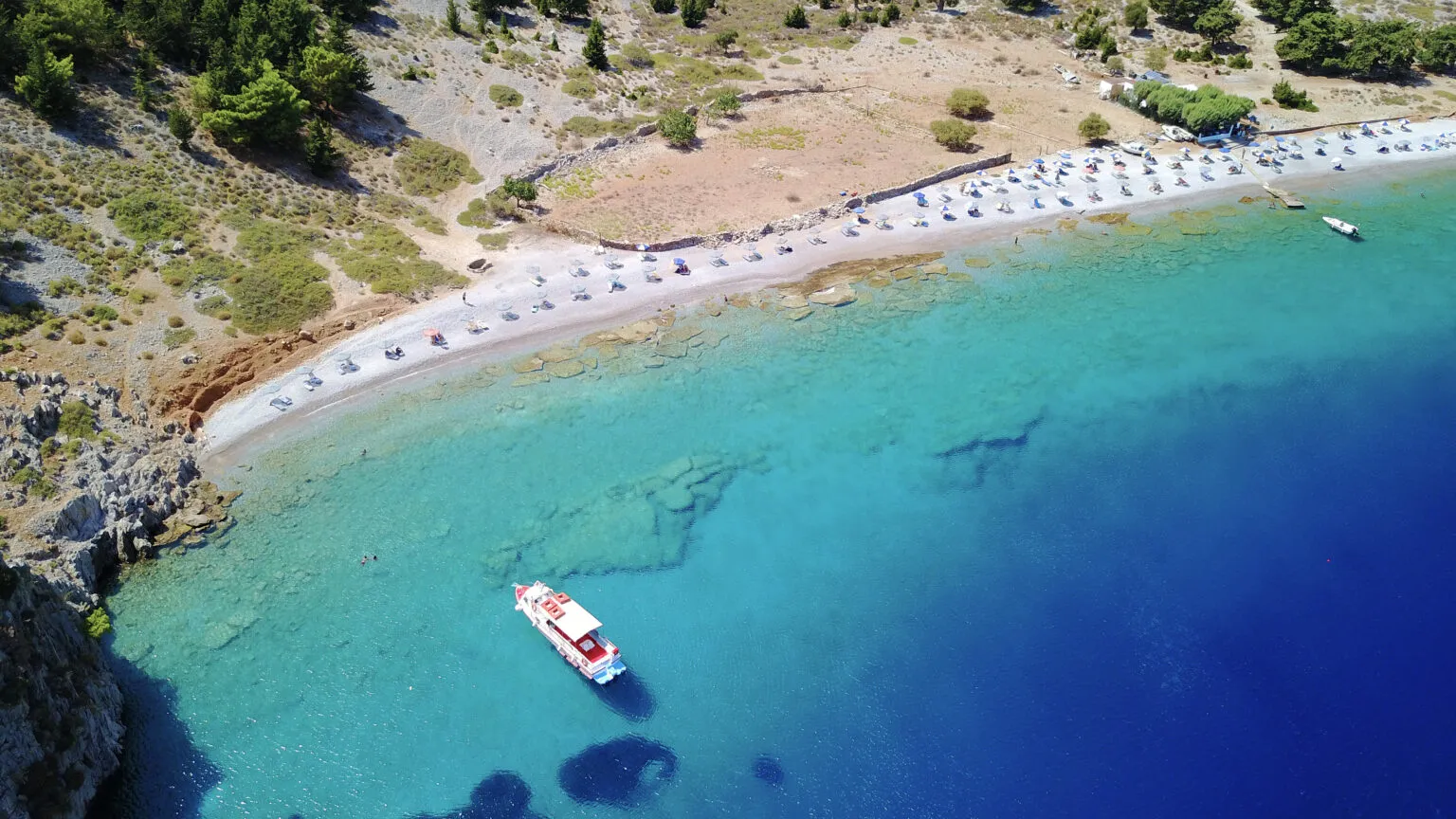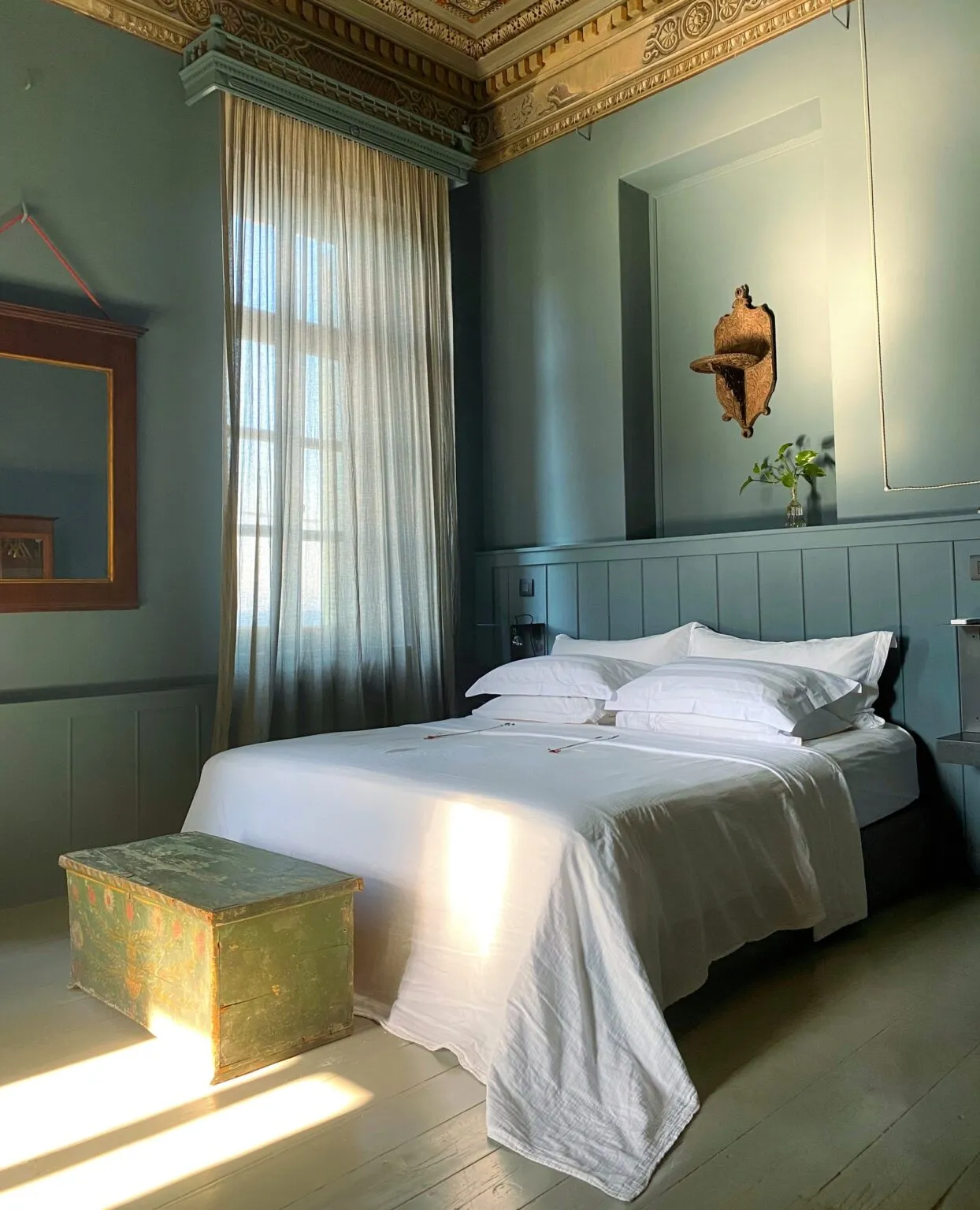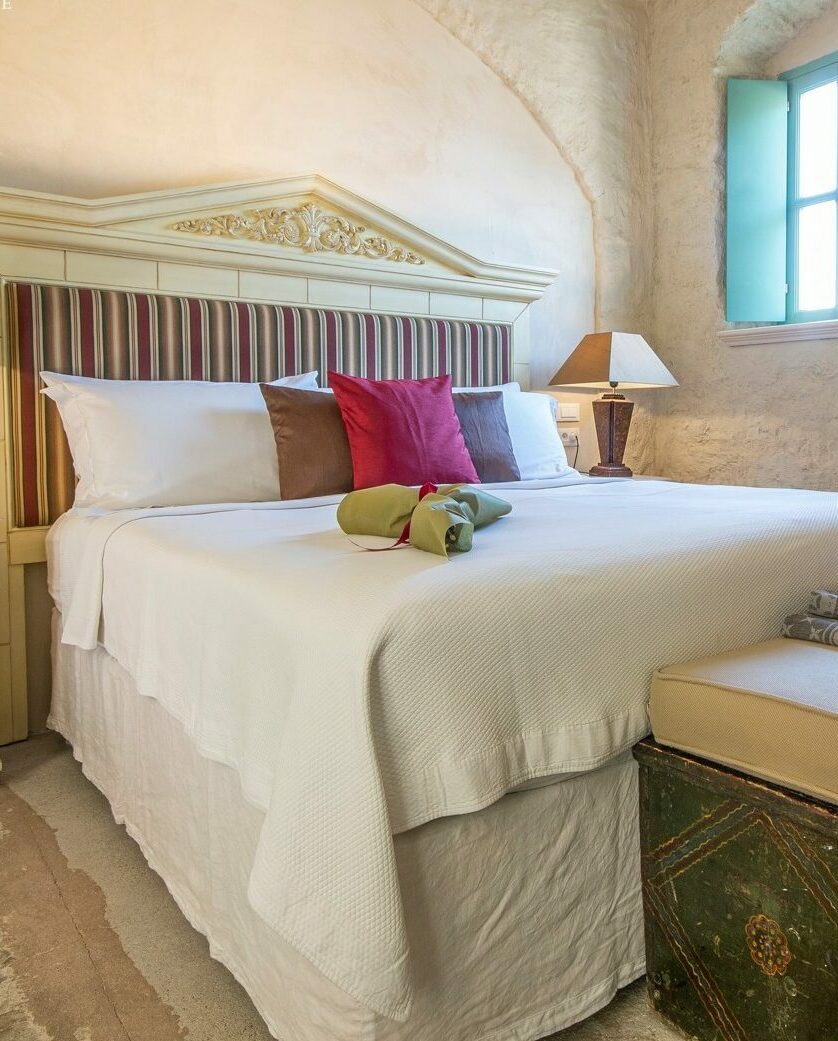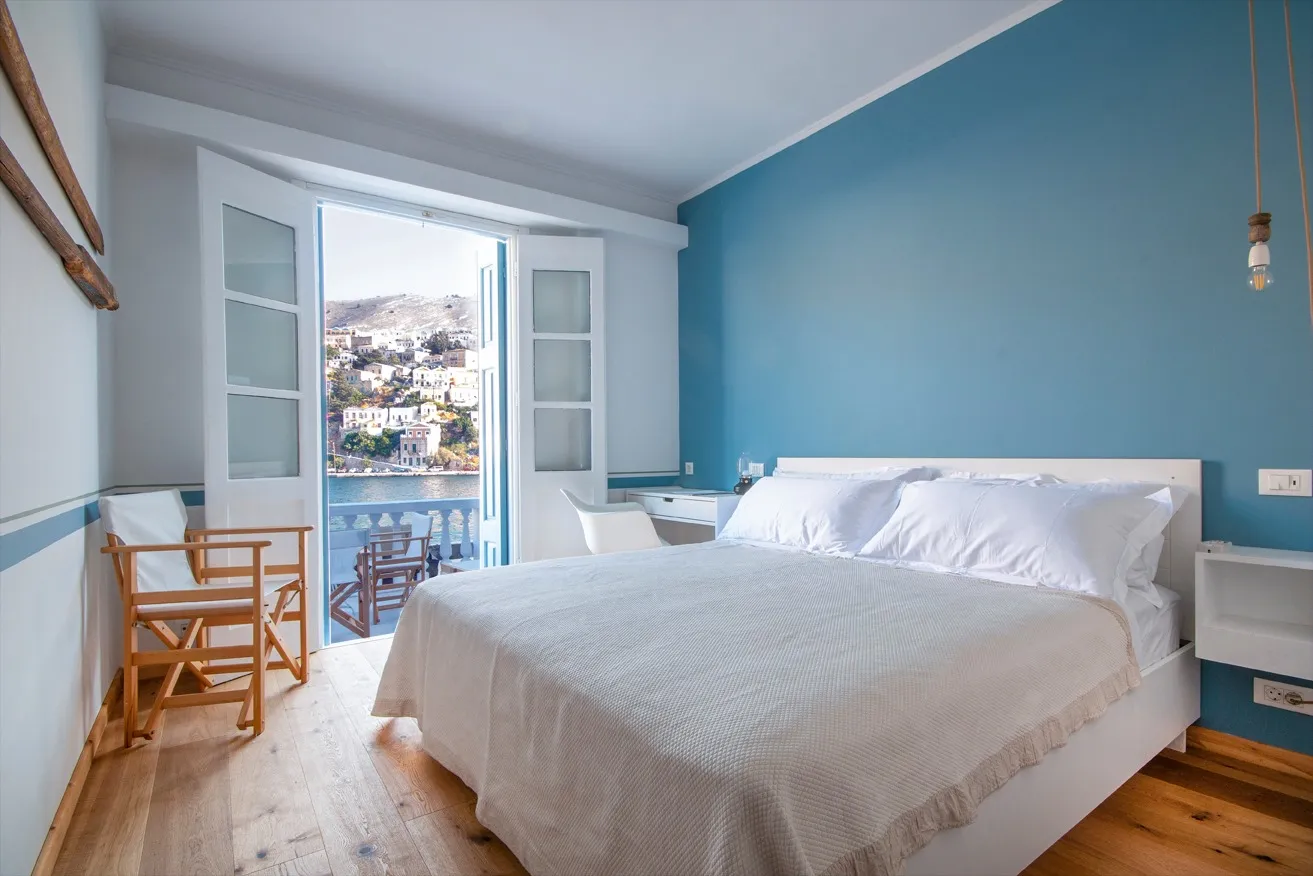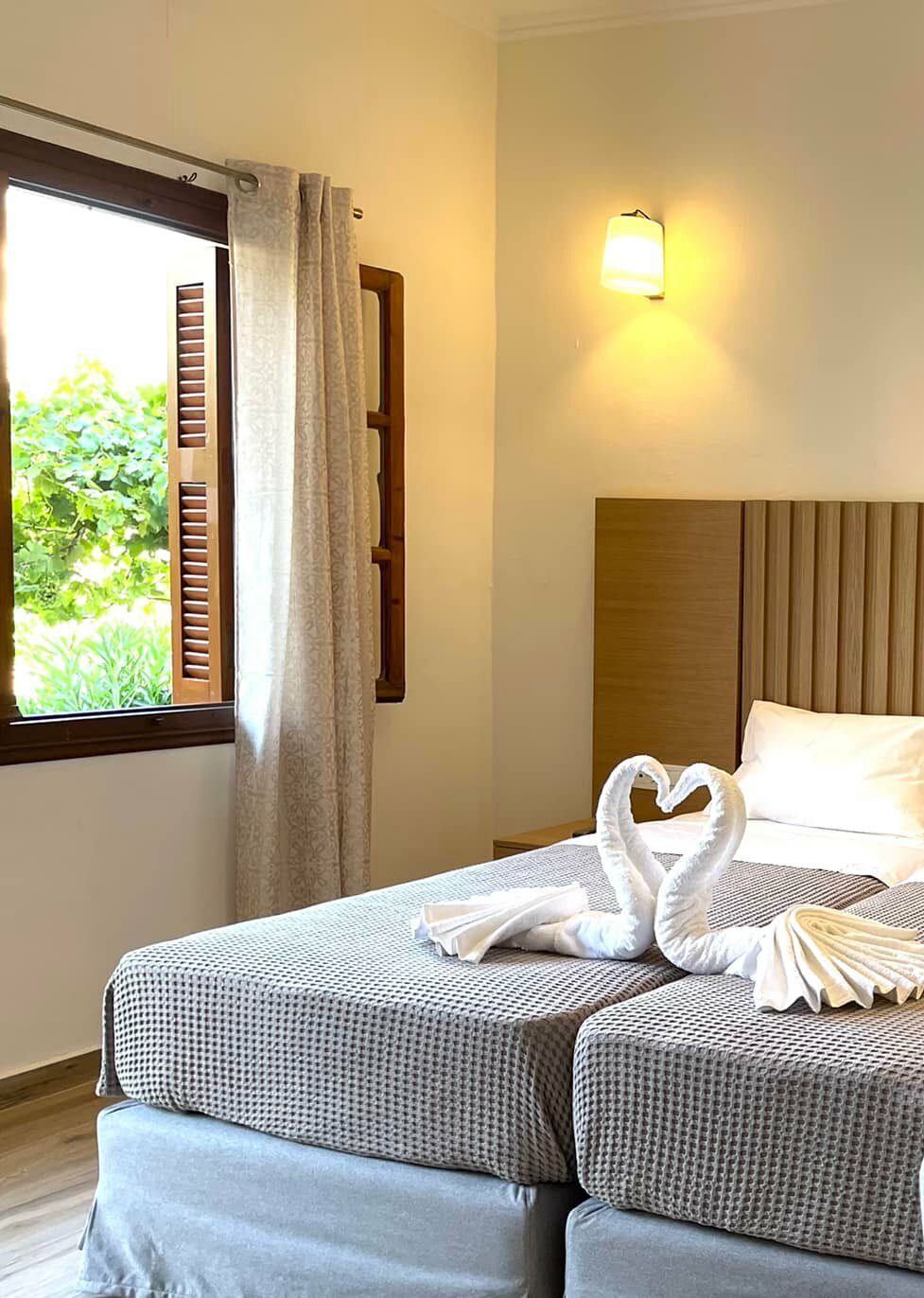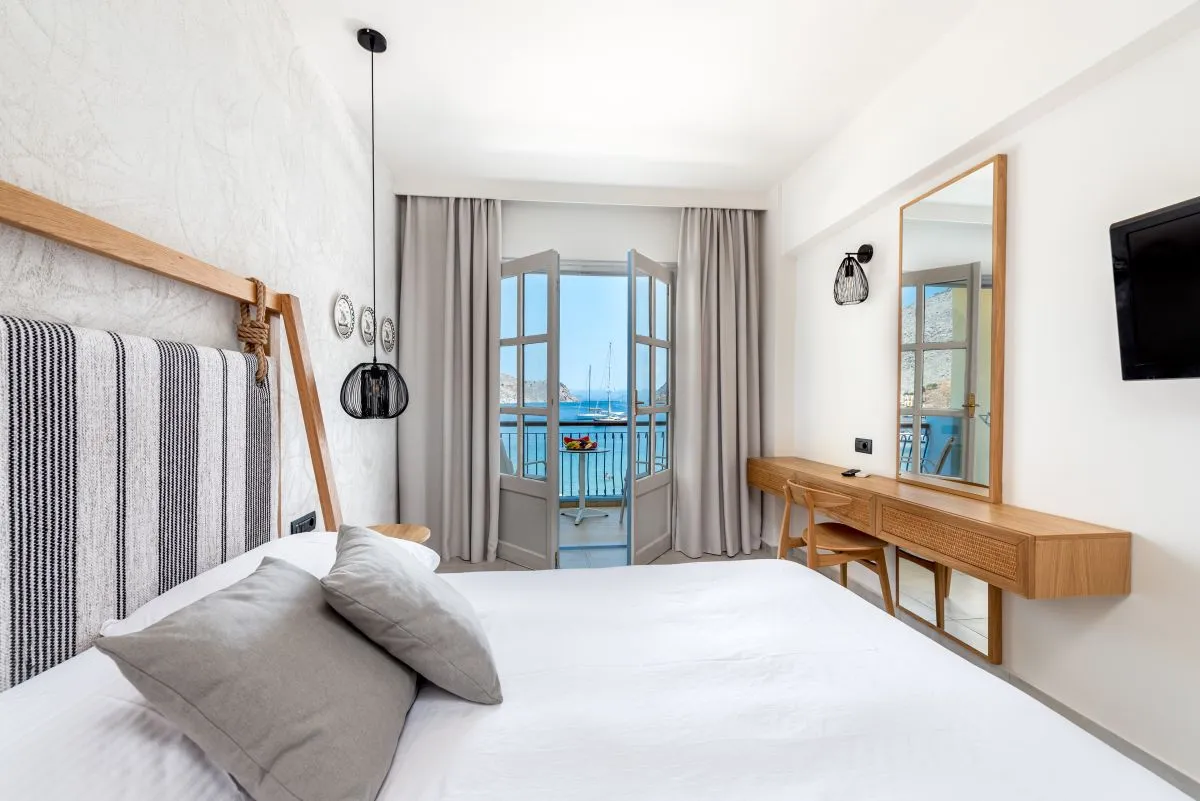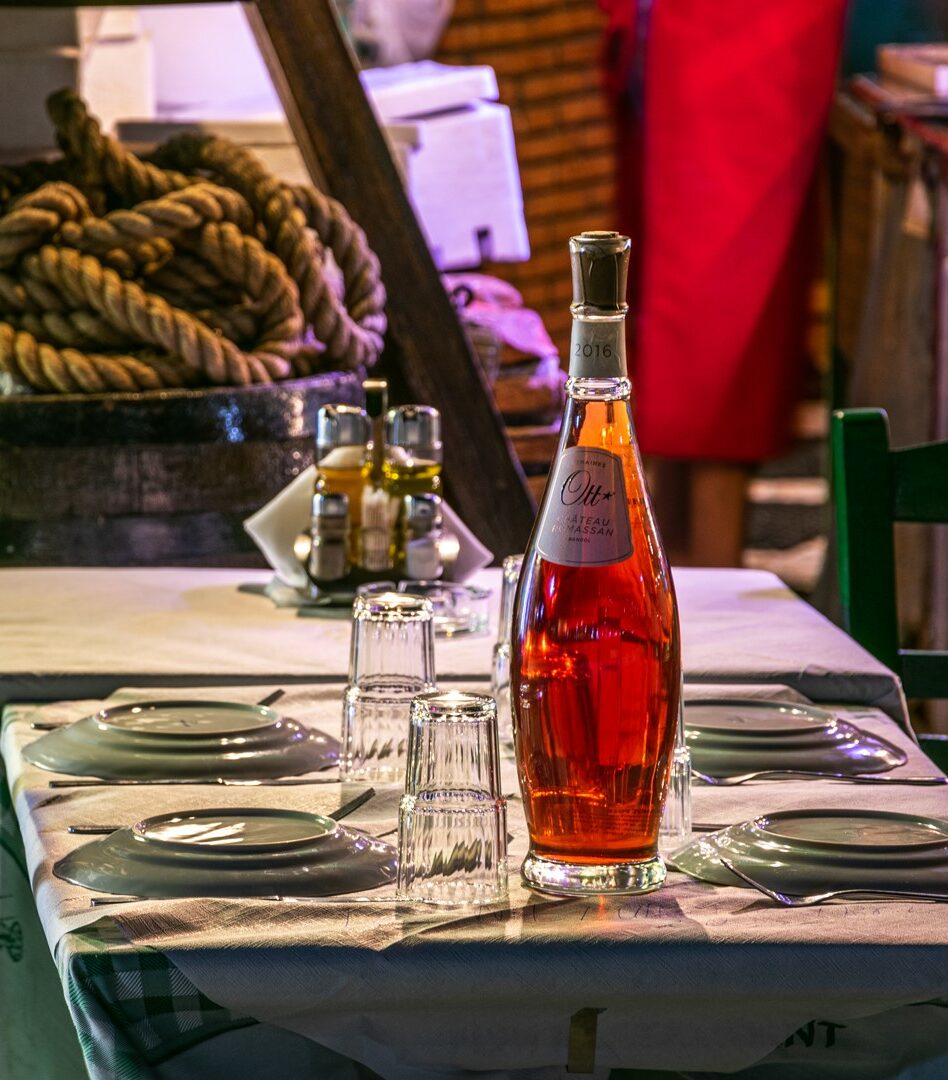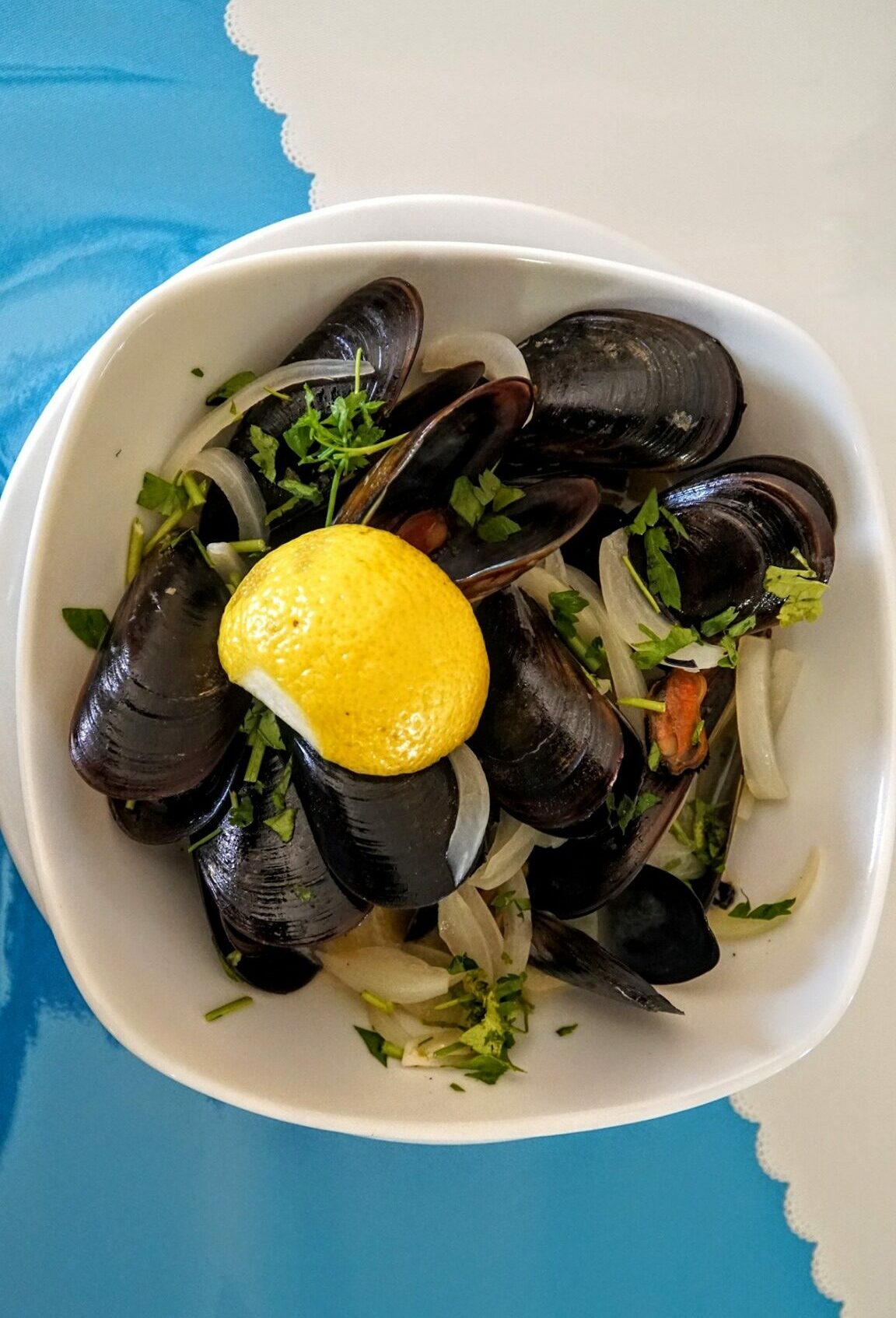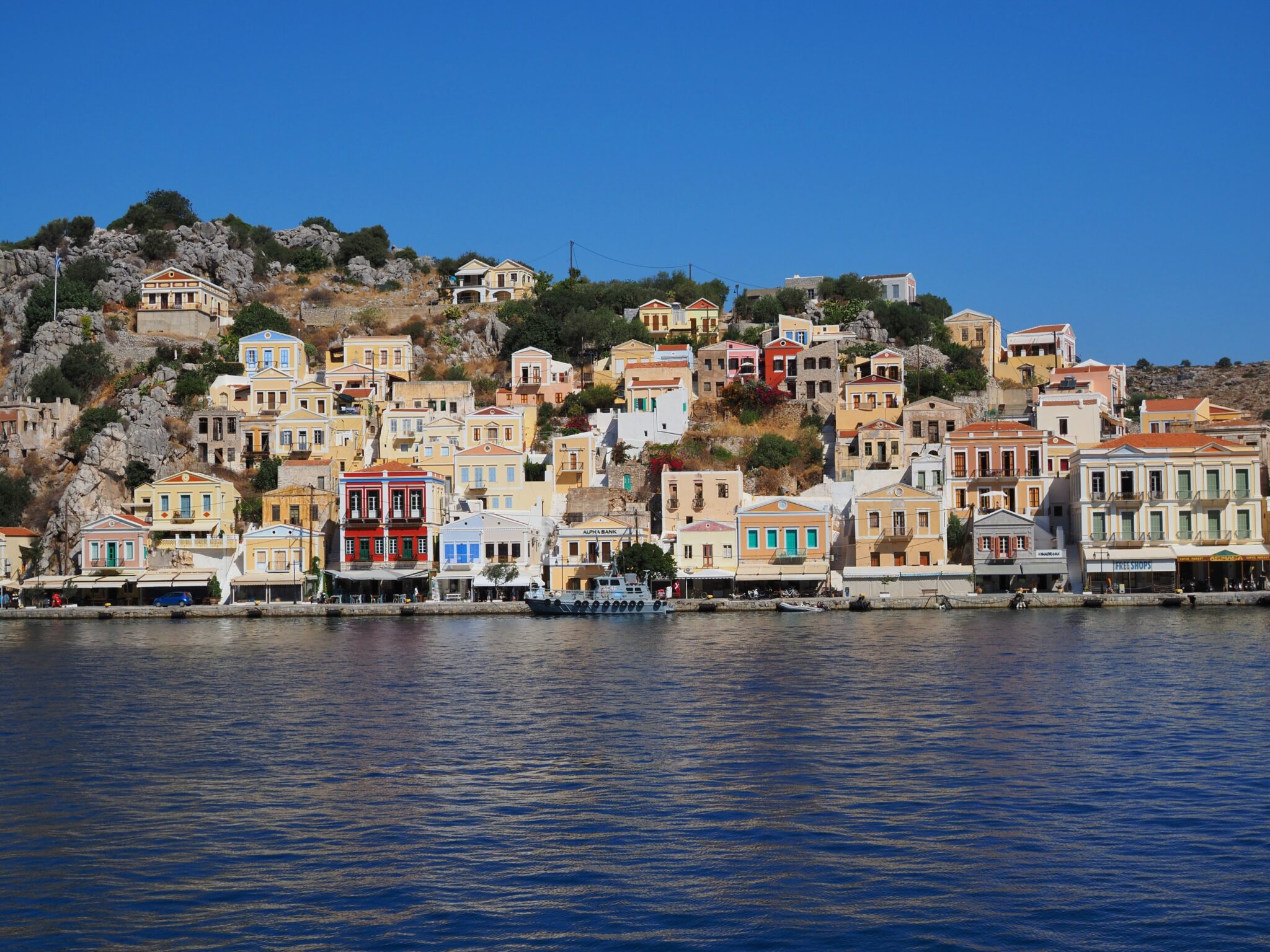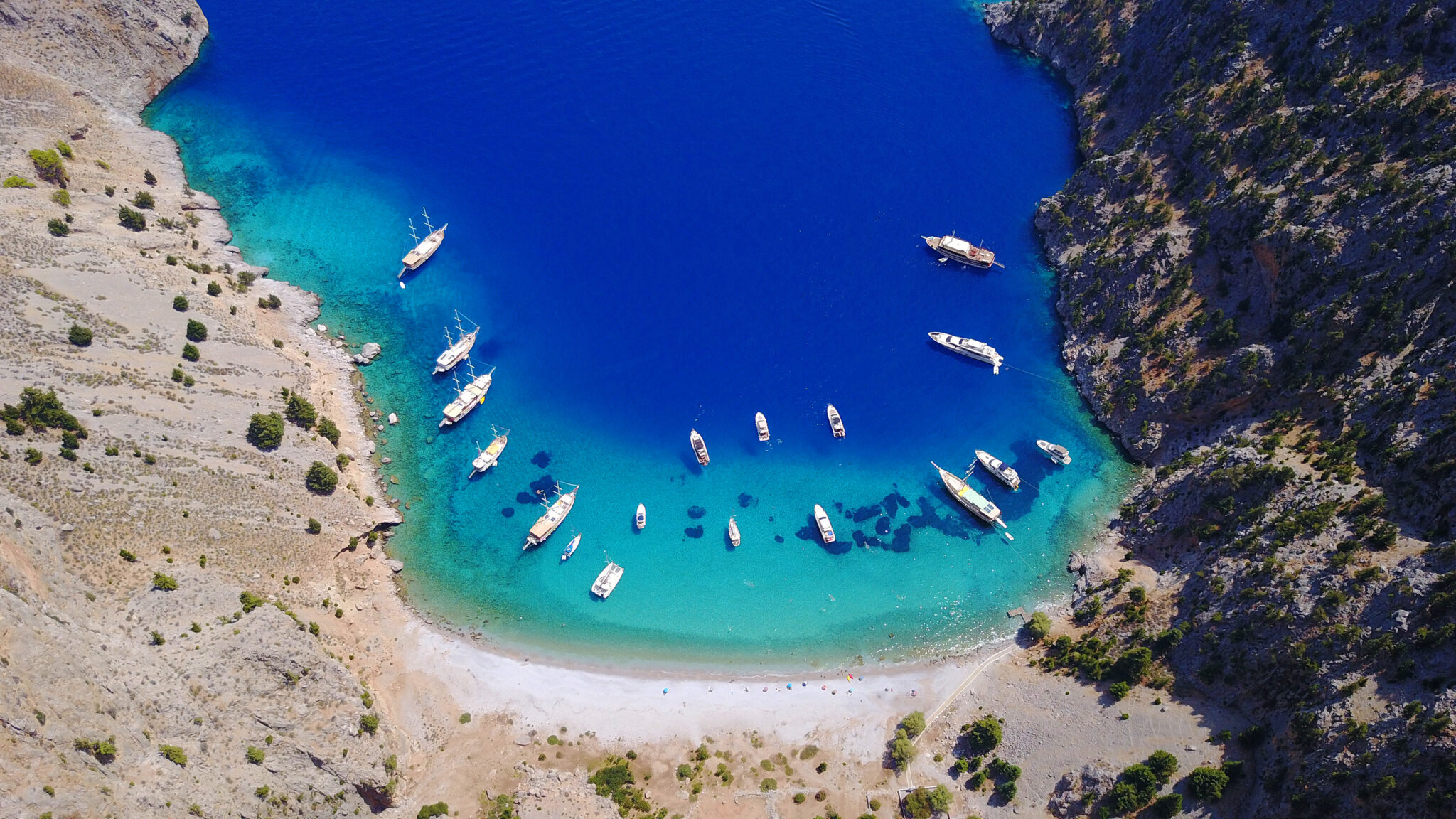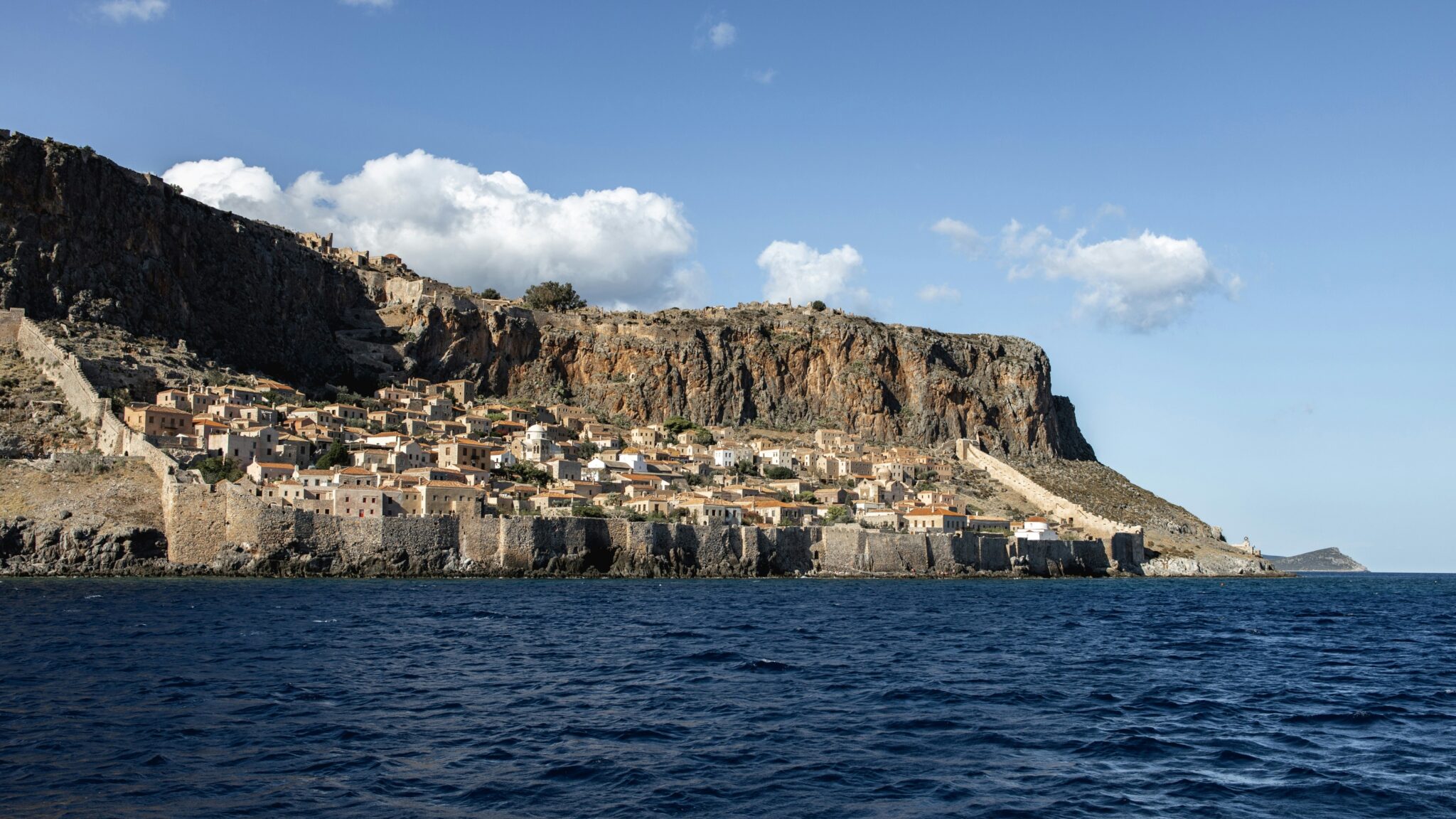The theatrical combination of neoclassical and island architecture harmoniously converge in a magnificently preserved settlement. Here, atmospheric small guest houses, villas, and fine restaurants line the streets, neighbouring beaches with crystal clear waters and the famous Panormitis Monastery above.
Cast to the edge of the Aegean but close to the cosmopolitan Rhodes, Symi is enjoying a renaissance. The impressive settlement, with startling architecture, colours and dimensions, has been extensively restored. Populated by Greeks and foreigners who have settled permanently – some even founding boutique hotels on the waterfront of Yialos – Symi maintains a delicate charm. Outside the bustle of the tourist season, when cruise ships and day boats crowd the harbour, one can luxuriate in the atmosphere of a sophisticated state that has long known how to mesmerise.
First Impressions
Take-off from El. Venizelos, landing in Rhodes, taxi, “dolphin,” departure, sea voyage, docking. The effort will reward you as you witness the islet of Symi seemingly levitating, in the still summer air, between past, present, and future. The once bustling polity of the 19th century with its 25,000 inhabitants enjoys the lifting of recent decades. Symmetrically placed, the “faces” of the mansions that line Yialos return your gaze: a preserved settlement unique in size and elegance.
Doors that are mouths, and windows that are eyes, all face the sea with bold combinations of shades and insignia that underline their noble origin. Time now is on their side. Italians, Germans, French, Scandinavians, English who bought them, have restored and tenderly cared for them. Their community is ever-growing, for the 360-degree turn life takes in Symi attracts more and more. However, the locals don’t treat it well, if you judge by the hundreds of scooters and cars that constantly annoy. Especially when you think that the longest asphalt road on the islet is just 22 kilometres long.
The Multicoloured Charm of Yialos
Ochre, salmon, red, blue, white. The colour palette becomes bolder in the grand neoclassical houses of Yialos. Higher up, the settlement of the Horio, a mix of Aegean architecture with fortified houses and Venetian elements, is equally impressive in appearance and size. Neoclassical facades, symmetrical openings, “anthropomorphic” buildings.
The settlement developed in the 15th and 16th centuries with densely erected buildings and vaulted passageways, and in the middle of the 19th century, it poured down to the seashore. It was mainly built by craftsmen from Karpathos. Following the standards of neoclassicism, the houses have tile roofs, gables, and many decorative elements. In earlier times, they were painted with lime, ochre, lilac, and brick-red—shades you see again today.
Pristine Urban Areas and a Wondrous Microcosm
In close proximity to the “Roloi” watchtower in Charani, and in points along Kali Strata, you’ll discover areas of Symi’s urbanity, with large and affluent houses resplendent in their architecture. Manor houses are also scattered throughout the village centre; however, it was common for the poorer classes to dwell higher up in the town.
The economic downturn of the island commenced in the 20th century, a result of the advent of steam power that made sailing ships redundant. This led to mass emigration. The devastation of the Second World War completed the picture of Symi’s abandonment. Thankfully, in 1975, the purchase and restoration of houses began, and the settlement was declared a preserved traditional area.
Navigating around the island of Symi, one finds the two sides of the harbour joined by a quaint stone bridge, known as the “kalntirimi,” beside which stand out the Customs House and the fish market. Walking from the bridge into the interior of the village, you reach Kambos square, graced with the statue of the history professor Michail Volonakis. Here, you’ll find the Town Hall and next to it the Nautical Museum.
Near the square rises the cathedral of Timios Prodromos, dating back to 1838. It is the metropolis of Symi, boasting an astonishing stone bell tower and pebbled courtyard. From the stone bridge, it’s worth taking a stroll towards Nos beach – especially at sunset time. Shortly, you’ll reach the monument dedicated to the executed soldiers and fighters during the Occupation. A few metres further down lie the former Kamposopoulou residence, where, on the 8th of May 1945, the Annexation Protocol and the handover of the Dodecanese to Greece were signed, as well as the unique relic of Italian rule, the building now housing the Police.
This journey through Symi’s streets, a small universe filled with historical wealth and cultural charm, offers a tantalising glimpse into an age both lost and preserved, echoing the island’s indomitable spirit and timeless elegance.
In this very neighbourhood stands the stone clock of 1881, and the so-called “Michalaki”, the statue of the little fisherman, a work by the Symian sculptor K. Valsamis. Once upon a time, the renowned Symi shipyard presided over the district of Charani. Upon the hill resides Our Lady of the Annunciation with its graceful bell tower. Continue along the shore for roughly a five-minute walk, and you will arrive at Nos beach.
Ascending to the Village from Kali Strata
Come sundown, brace yourself against the damp heat, muster your courage, and ascend the 500 steps of Kali Strata that connects Yialos to the Village (Upper Symi), all the while envying those fortunate souls who read and admire the view from the wooden balconies of restored mansions. You’ll await the sun’s descent seated in a shady cafe, finding your way through neighbourhoods – the Syllago, the Vigli, the Katarraktis, the Lieni – only to quickly realise that appearances can deceive: the Village settlement, besides being breathtakingly beautiful, is also vast indeed. You’ll confirm this, by climbing higher to Our Lady of the Castle, to mentally map the area and listen to the priest narrate how the temple’s icons were saved before the old church was blown up during World War II. In the neighbourhood of Saint Athanasius, divided into two buildings from the 18th and 19th centuries, you’ll find the Archaeological and Folklore Museum. The exhibits date from prehistory to the 19th century (Phone: +30 22460 70010).
One senses the whispers of history as one wanders through these lands, feeling the echoes of a bygone era in every stone and wave. Symi, in her rugged beauty, invites you to delve deeper, and in doing so, reveals a microcosm that holds within the stories of Greece, both ancient and modern. Whether you find yourself staring at the setting sun from Nos beach or listening to tales of salvation in the church, you’ll be wrapped in an enigmatic charm that only this island can provide. The view from the wooden balconies may entrance the fortunate few, but the experience of Symi, rich and multifaceted, is a treasure awaiting all who take the time to explore by walking through it.
The Famed Pilgrimage of Panormitis
The island’s grandest trail leads to Panormitis’ revered shrine, a place honoured throughout all of Greece. Its commencement is an uphill challenge, granting exceptional panoramic vistas of Yialos and the Village – prepare therefore to make frequent stops for photographs. At the cove where your journey culminates, the famed Monastery of Archangel Michael stands dominant. According to manuscripts, it has been there since the 15th century and was erected in honour of Archangel Michael whose icon, adorned with silver and gold, is considered miraculous.
The magnitude of the complex and the elegance of the bell tower, constructed in 1911, are as striking as the tales told of the image and the Archangel: the story universally narrated is that he’s dubbed “the thief,” for “if his votive offering is not rendered, he always finds a way to take it.” The day boats bring dozens of pilgrims to Panormitis every day, while many locals rent cells of the complex and assist in chores, concurrently enjoying a summer retreat. Equally striking is Panormitis’ glebe, “Megalos Sotiras” (Great Saviour), also fortress-like, on the road to the monastery.
The Naval Museum of Symi and the Lost Traditional Shipyards
Housed in a meticulously preserved neoclassical building in Yialos, it’s considered one of Greece’s most prominent naval museums. It hosts exhibits about sponge fishing, including diving suits, various kinds of sponges and “bell stones.” Together with these, you will marvel at models of sponge-fishing vessels. (Phone: +30 22460 72363). Besides sponge fishermen and merchants, the people of Symi were exceptional shipbuilders. In Niborio, the once-renowned shipyard of Symi is facing decline, and the old masters – save for two brothers striving to preserve the tradition – are now but a distant memory. Plastic boats have unceremoniously ousted the old wooden crafts that demanded so much skill, time, and artistry to “build.”
Bathing, on Foot and by Boat
In Symi, you won’t find sandy expanses; the beaches are strewn with pebbles or adorned with large stones. Weather permitting, you’ll revel in the splendidly clear waters and the stunning landscapes that surround them. Yialos Beach, known as Nos, is within walking distance and a fine option if you prefer not to take a boat. Furnished with umbrellas and sun loungers, it’s often bustling.
Not far away lies Niborio, or Emporeios, Symi’s second port. Here you’ll find a pebbled, narrow beach in an open cove, equipped with umbrellas and sun loungers. Accessible by vehicle is Marathounda Beach, a stony enclave with gorgeous waters and tranquillity. Families tend to favour Pedi, especially the area in front of Pedi Beach.
Boats will transport you to specific beaches on the island’s eastern side (for others, special arrangements must be made with the boatmen).
Whether by foot or by boat, Symi’s coastlines offer a blend of experiences, from the convenience of Nos to the peaceful seclusion of Marathounda. Choose your setting and let the crystal-clear waters and striking surroundings wash over you, for an experience as pleasing to the eye as it is to the soul.
The islet of Agia Marina, on the northern shore of Pedio’s Bay, sports a slender beach and jetties ideal for diving into. Famous and breathtaking is Agios Georgios o Dysalonas, with its sheer, cut-like cliffs and azure waters that shimmer with emerald light. This is considered one of the island’s finest, as is Nanou, which is distinguished by its coarse pebbles. From the best beaches, Agios Vasileios is a hidden cove to the southwest, accessible by boat or footpath. This beach is secluded and favoured by naturists.
In Panormitis, there is a petite beach, and beside it, Fanneromeni, where footpaths will lead you. It would also be wise to take a boat to the small islets of Seskli and Nimos, with their plages, as well as to Agios Aimilianos (reachable by footpath, but it’s a 2.5-hour walk), and the neighbouring Gaidouromantra. Opposite Agios Aimilianos is Fokospilia. Inside this cave is a hidden little beach with pebbles. Should you encounter any seals, particularly if they’ve just given birth and are caring for their young, make certain they remain undisturbed.
Where to Stay
1900 Hotel: the neoclassical mansion of the Mastoridis family has a history behind it. Gifted to Captain Mastoridis by the whom English he served in 1862, it was his reward for bringing the first diving suit to Greece and Symi. Intriguingly, his wife, not a man, was the first to dive with it. The hotel hosts four elegantly decorated suites, with the building’s authentic architectural elements in full view. They boast delightful colour combinations, a mix-and-match decoration of modern and classical furniture and objects. Upstairs, the terrace offers a vista that’s uniquely its own.
The Old Markets, in Kali Strata: Restored since 2016, the old market buildings along with the adjacent captain’s house have been transformed into sophisticated guest spaces. The decoration is minimal, with earthy tones and the use of stone in the suites and rooms, marked by Ottoman influence.
Ιapetos Village: Nestled in Gialos, a cluster of traditional homes with a pool, pool bar, and beautiful garden. It offers suites, studios, and apartments with elegant classic decor.
Limani Life: A small hotel overlooking the waterfront of Gialos. It offers rooms with balconies or terraces, tastefully painted and decorated.
Opera House: Colourful buildings in Gialos house simply decorated rooms with balconies. A garden is also part of the appeal.
Pedi Beach: A renovated unit suitable for families on Pedi beach where the hotel provides umbrellas and sun loungers. Rooms offer minimalist, modern decoration with views of the sea. A taverna operates on site.
Aliki: Located in Gialos, just a few metres from the water, this building from 1895 was once part of a dowry for the mother of the late George Gennimatas. Spaces and rooms are classically decorated.
For houses and villas, look at www.kalodoukas.gr and on the various platforms.
Dining in Symi
On the dazzling island of Symi, indulge your palate with delectable dishes and traditional tastes. Here’s a brief guide to some culinary hotspots:
Tholos: Situated beside the port with a view of the charming Chora, “Tholos” is a must-visit. Taste the famous Symi shrimp, delightful appetizers, stuffed cabbage rolls, goat meat, and chickpea stew. The ambiance and local flavours will captivate your senses.
Manos Fish Taverna: Located at the heart of the harbour, “Manos” is renowned for fresh fish and seafood. Frequented by a famous clientele, this tavern often hosts wonderful musical and dance events, providing both delicious fare and lively entertainment.
Marathounta Taverna: After a refreshing swim, head to “Marathounta” to savour freshly-caught fish and traditional Symi mezes. This seaside tavern captures the essence of Greek hospitality, offering a relaxing dining experience by the waves.
Read also:
Symi: Dodecanese island resembling the Italian Riviera



